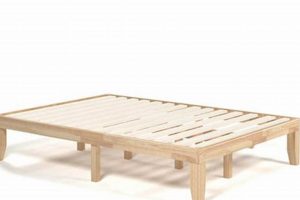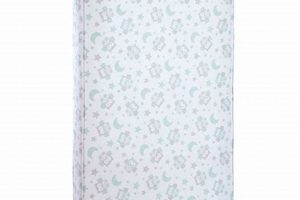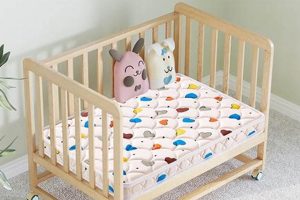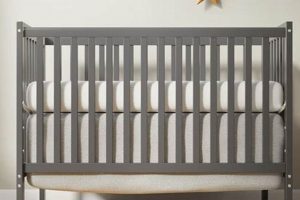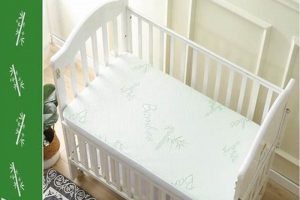A common question for new parents concerns the dimensions of bedding designed for infant sleep spaces. Specifically, understanding the appropriate measurements ensures both safety and proper fit. The generally accepted measurement for these mattresses is approximately 28 inches wide by 52 inches long, with a thickness that typically does not exceed 6 inches.
Adherence to established dimensional standards is crucial for infant well-being. A snug fit minimizes the risk of entrapment between the mattress and crib frame, preventing potential suffocation hazards. Historically, inconsistent sizing presented challenges for consumers, prompting the establishment of industry regulations to promote uniformity and safety in crib mattress manufacturing. These standards offer peace of mind to caregivers.
The ensuing discussion will elaborate on the factors influencing mattress choice, including material composition, certifications, and additional considerations to guarantee a secure and comfortable sleep environment for infants. This detailed exploration aims to equip individuals with the knowledge necessary to make informed purchasing decisions.
Guidance on Selecting Correct Dimensions for Infant Bedding
Ensuring the proper dimensions for an infant’s sleep surface is paramount for safety and comfort. The following guidelines address key considerations when choosing appropriate bedding.
Tip 1: Always verify that the mattress meets the federally mandated dimensions for a standard crib. This helps ensure a snug and secure fit within the crib frame.
Tip 2: Prioritize mattresses bearing certifications from reputable organizations, such as the Juvenile Products Manufacturers Association (JPMA). Certification indicates adherence to stringent safety standards.
Tip 3: Measure the interior dimensions of the crib before purchasing a mattress. While generally standardized, slight variations in crib construction may exist.
Tip 4: Inspect the mattress packaging for clear indication of size specifications. Manufacturers are required to provide this information prominently.
Tip 5: After placing the mattress in the crib, verify that the gap between the mattress edge and the crib frame does not exceed two fingers’ width. Excessive gaps pose a safety hazard.
Tip 6: Consider the weight and density of the mattress. A firmer mattress provides better support for the infant and reduces the risk of suffocation.
Tip 7: Regularly inspect the mattress for signs of wear and tear, such as sagging or tears in the covering. Replace the mattress if any damage is detected.
By following these guidelines, caregivers can mitigate risks associated with improperly sized bedding and cultivate a safer sleep environment for infants. Adherence to these recommendations promotes both physical well-being and parental peace of mind.
The following section will delve into the various materials used in constructing these mattresses, along with their respective advantages and disadvantages, to further aid in the selection process.
1. Width
The width of a standard crib mattress is a critical dimension dictating its compatibility and safety within standard crib frames. Consistent adherence to established width specifications is paramount in preventing hazardous gaps and ensuring infant security.
- Standard Dimension Compliance
The generally accepted width for these mattresses is approximately 28 inches. This dimension is not arbitrary; it is a result of industry consensus and regulatory oversight aimed at promoting uniform sizing. Deviation from this standard can compromise safety. Non-compliant examples include mattresses that are too narrow, creating gaps where infants can become trapped, or mattresses that are too wide, preventing proper installation within the crib frame.
- Impact on Crib Functionality
The width directly influences the overall functionality of the crib. A correctly sized mattress allows for proper sheet fitting and prevents bunching or looseness, reducing the risk of entanglement. Conversely, an incorrectly sized mattress can lead to difficulties in securing bedding properly. Real-world scenarios demonstrate that improper width can render certain crib models unusable or necessitate custom bedding solutions, adding inconvenience and cost.
- Relationship to Safety Regulations
Width specifications are often integrated into safety regulations governing crib mattress manufacturing. These regulations, enforced by agencies such as the Consumer Product Safety Commission (CPSC), aim to minimize hazards associated with improperly sized bedding. Compliance with these standards is crucial; non-compliance can result in product recalls and legal ramifications. For instance, mattresses failing to meet width requirements due to manufacturing defects have been subject to recalls, emphasizing the importance of rigorous quality control.
- Considerations for Material Compression
The stated width may vary slightly depending on the mattress material and its compression characteristics. Foam mattresses, for instance, may compress more than innerspring models. This compression can affect the perceived width when the mattress is placed under an infant’s weight. It is therefore essential to consider the mattress’s construction and material properties when evaluating its suitability for a standard crib frame. Real-world observations show that excessive compression can lead to gaps forming over time, requiring regular inspection and potential replacement.
The width dimension of infant bedding is inextricably linked to the safety and functionality of standard cribs. Adherence to established width specifications is not merely a matter of convenience; it is a critical factor in mitigating potential hazards and ensuring a secure sleep environment for infants. Ignoring or deviating from these standards can have serious and potentially life-threatening consequences.
2. Length
The length dimension of a standard crib mattress is inextricably linked to infant safety and proper fit within a crib frame. As a core component of the overall size, its standardized measurement ensures a secure sleep environment. Deviations from the established length can create hazardous conditions, such as gaps between the mattress and the crib sides, increasing the risk of entrapment. The generally accepted length is approximately 52 inches. A practical illustration of its significance is evident in the design of cribs themselves; they are manufactured to accommodate this length, and any variance can compromise the intended safety mechanisms. Failing to adhere to this measurement can render a mattress incompatible, negating the purpose of safety regulations.
Proper length has a cascading effect on other aspects of the sleep environment. For instance, appropriate sheet sizing is dependent on a mattress adhering to the standardized length. If the mattress is too short, sheets will fit loosely, posing a potential suffocation hazard. Conversely, a mattress that exceeds the specified length may be difficult to insert into the crib frame, increasing stress on the structure and reducing its lifespan. The correlation extends to the function of drop-side cribs (while largely phased out due to safety concerns), where correct mattress length was crucial to ensure the drop-side mechanism operated without interference.
In summary, the length dimension is an indispensable attribute defining a standard crib mattress. Its proper implementation is not merely a matter of dimensional accuracy; it directly impacts infant well-being, safety compliance, and crib functionality. A deficient understanding or disregard for this fundamental measurement can lead to considerable safety risks. Therefore, verification of the mattress length before purchase and during installation is of paramount importance.
3. Thickness
Thickness, as it relates to a standard crib mattress, represents a critical dimension influencing both safety and functionality. While width and length establish the overall footprint, thickness governs the vertical space the mattress occupies within the crib. Deviation from acceptable thickness parameters presents a risk of compromised structural integrity of the crib or increased potential for infant injury. Standard thickness does not generally exceed six inches, a measure implemented to prevent infants from using the mattress as leverage to climb out of the crib. Exceeding this maximum thickness can directly increase the risk of falls, rendering the crib unsafe. Similarly, inadequate thickness compromises support, potentially leading to discomfort or contributing to positional asphyxia in infants lacking adequate head and neck control. The measurement is thus linked intrinsically to ensuring a safe sleep environment.
The selection of appropriate mattress thickness also impacts the intended performance of the crib’s side rails. With side rails engineered to a fixed height, a mattress that is too thick reduces the effective height of the rails, essentially nullifying their safety function of containing the child within the crib. In contrast, a mattress that is too thin creates a gap between the top of the mattress and the bottom of the side rail, posing a potential entrapment hazard. Historical examples of injuries resulting from non-compliant mattress thickness underscore the need for strict adherence to established standards. A mattress used in a crib should leave no more than 2 inches between top of the mattress and lowest part of the frame.
In summary, mattress thickness is not a standalone attribute but an integrated component crucial to understanding overall mattress dimensions. It is vital to verify that the thickness complies with crib manufacturer specifications and regulatory standards. A lack of understanding or due diligence in confirming appropriate thickness can lead to serious safety consequences. Careful consideration of this dimension serves as a proactive measure to maintain a secure sleep environment for infants, directly contributing to reduced risk of injury or harm.
4. Rectangle
The rectangular shape is an intrinsic characteristic of a standard crib mattress, directly influencing its compatibility with crib frames and impacting overall safety. The consistent adherence to this geometric form ensures uniformity and predictability in product design.
- Geometric Conformity
The rectangular shape permits the mattress to fit snugly within the confines of the crib. The consistent 90-degree angles and defined side lengths minimize the potential for gaps, which could pose an entrapment risk for infants. Deviations from this rectangular form would necessitate alterations in crib design to maintain safety standards, illustrating the importance of this geometric property.
- Efficient Space Utilization
The rectangular shape optimizes the use of space within the crib. Its straight edges and corners allow for efficient placement against the crib’s side rails, maximizing the usable sleeping area. Alternative shapes, such as ovals or circles, would inherently waste space, reducing the available area for the infant to move and potentially increasing the risk of restricted movement.
- Manufacturing Standardization
The rectangular shape simplifies the manufacturing process, promoting consistency and reducing production costs. Its uniform angles and dimensions allow for automated cutting and assembly techniques, resulting in a more standardized product. Non-rectangular mattresses would require more complex manufacturing processes, potentially increasing production costs and introducing greater variability in the final product.
- Bedding Compatibility
The rectangular shape facilitates compatibility with standard crib bedding, such as fitted sheets and mattress protectors. The consistent dimensions of the mattress enable manufacturers to produce bedding that fits securely and prevents bunching or slippage, reducing the risk of suffocation. Non-rectangular mattresses would necessitate custom-made bedding, increasing costs and limiting consumer options.
The rectangular shape of a standard crib mattress is not merely an aesthetic choice but a critical design element that contributes significantly to safety, functionality, and manufacturing efficiency. The geometrical form provides a foundation for uniform fit within the crib structure. Its implications extend from mitigating entrapment risks to simplifying bedding compatibility, underscoring the shape’s relevance.
5. Uniformity
Uniformity in crib mattress dimensions is not an ancillary feature, but rather a cornerstone of infant safety and regulatory compliance. The standardized size, defined by approximate measurements of 28 inches in width and 52 inches in length, with a maximum thickness of 6 inches, necessitates a high degree of consistency across manufacturers and product lines. This dimensional conformity is crucial in preventing hazardous gaps between the mattress and the crib frame. Without uniformity, the potential for infant entrapment and subsequent suffocation is significantly elevated. Regulatory bodies such as the Consumer Product Safety Commission (CPSC) enforce these standards to mitigate these risks, reflecting the direct causal relationship between uniform sizing and improved infant safety. The absence of uniformity directly undermines the safety measures integrated into crib design. A lack of dimensional consistency introduces unacceptable levels of risk.
The practical significance of dimensional uniformity extends beyond immediate safety considerations. Standardized sizing allows for seamless interchangeability of crib bedding, such as fitted sheets and mattress protectors. This facilitates ease of use for caregivers and ensures that the bedding fits snugly, further minimizing potential hazards related to loose fabric. Furthermore, uniform mattress dimensions simplify inventory management for retailers and reduce confusion for consumers. Real-world examples of non-uniform mattresses highlight the challenges and risks involved, often requiring custom bedding solutions or resulting in unsafe crib configurations. The presence of a non-uniform mattress directly challenges the intended features of the crib, impacting every aspect from sheet-fitting to side-rail safety.
In summary, the uniformity of crib mattress dimensions is paramount. The practical application extends to many areas and directly impacts crib structure, and therefore crib mattress design for infant well-being, safety compliance, and consumer convenience. Challenges arise when manufacturing deviations occur, necessitating rigorous quality control measures and vigilant consumer awareness. The pursuit and maintenance of uniformity is an ongoing commitment to ensuring the safest possible sleep environment for infants. A uniform-sized mattress is required for a safe crib.
6. Inner Dimensions
The inner dimensions of a crib are the primary determinants of appropriate mattress size. The reciprocal relationship dictates that a standard crib mattress, with its established dimensions, is designed to fit securely within a crib adhering to corresponding internal measurements. The inner dimensions, therefore, serve as a critical parameter influencing mattress selection. Variations in these dimensions can directly impact the safety and functionality of the sleep environment. For example, if the inner dimensions of the crib are smaller than the standard mattress size, proper installation becomes impossible, potentially leading to damage to the crib structure or an unsafe sleeping surface. Conversely, if the inner dimensions exceed the mattress size, hazardous gaps can form, posing a significant entrapment risk to the infant.
Several factors can influence the inner dimensions of a crib. Manufacturing tolerances, variations in design across different crib models, and even minor structural damage can alter these measurements. Therefore, relying solely on the “standard” designation can be insufficient. Verification of the crib’s inner dimensions is crucial prior to purchasing a mattress. This proactive measure enables caregivers to ensure a snug fit and minimize the risk of potential hazards. A practical illustration of this principle involves measuring the width and length between the interior surfaces of the crib frame, comparing these measurements to the stated dimensions of the prospective mattress, and confirming that the mattress will fit without excessive force or creating substantial gaps. Furthermore, used cribs or those that have undergone assembly and disassembly should be measured with particular care, as these are more susceptible to dimensional inconsistencies.
In summary, the connection between inner dimensions and the appropriate mattress size underscores the importance of precise measurement and compatibility. Variations in inner dimensions can compromise safety, functionality, and the overall integrity of the sleep environment. Prioritizing accurate measurements and a thorough understanding of the reciprocal relationship between these two factors is essential for ensuring infant well-being and adherence to established safety standards. The challenges associated with dimensional variations necessitate a vigilant approach to mattress selection and installation, highlighting the practical significance of this understanding in safeguarding infants from potential harm.
Frequently Asked Questions
This section addresses common inquiries regarding the dimensions of standard crib mattresses and their implications for infant safety.
Question 1: What constitutes the generally accepted dimensions of bedding designed for infant sleep?
The established measurements for a standard crib mattress are approximately 28 inches in width and 52 inches in length, with a thickness not exceeding 6 inches. These dimensions are critical for ensuring a secure fit within standard-sized crib frames.
Question 2: Why is adherence to specific dimensional standards so crucial for infant well-being?
Compliance with established dimensions minimizes the risk of entrapment between the mattress and the crib frame, a potential suffocation hazard. A snug fit is paramount in creating a safe sleep environment.
Question 3: What are the potential consequences of using a mattress that does not conform to the specified dimensions?
A mattress that is too small can create gaps between the mattress and the crib sides, increasing the risk of entrapment. Conversely, a mattress that is too large may not fit properly, compromising the structural integrity of the crib.
Question 4: How can caregivers ensure that the purchased mattress meets the required dimensional standards?
Caregivers should measure the interior dimensions of the crib before purchasing a mattress and compare those measurements to the stated dimensions of the mattress. Additionally, seeking certifications from reputable organizations ensures adherence to safety standards.
Question 5: Are there any circumstances under which deviations from the standard dimensions might be acceptable?
Deviations from the standard dimensions are generally not recommended. In specific cases, such as custom-built cribs, a non-standard mattress may be required, but careful consideration must be given to ensure a secure and safe fit.
Question 6: What role do regulatory agencies play in enforcing dimensional standards for crib mattresses?
Regulatory agencies, such as the Consumer Product Safety Commission (CPSC), establish and enforce safety standards for crib mattresses, including dimensional requirements. These regulations aim to minimize hazards associated with improperly sized bedding.
Adherence to the standard crib mattress dimensions is a fundamental aspect of infant safety. Disregarding these standards can have serious and potentially life-threatening consequences.
The subsequent section will delve into the selection of appropriate bedding materials and additional safety considerations for infant sleep environments.
Conclusion
The preceding exploration of what size is a standard crib mattress underscores the criticality of adhering to established dimensional guidelines for infant safety. This discussion illuminates the potential hazards associated with deviations from standardized measurements, emphasizing the risks of entrapment and suffocation. The analysis of individual dimensionswidth, length, thickness, and shapereinforces the interconnectedness of these factors in ensuring a secure sleep environment. Careful attention to detail in mattress selection, guided by an understanding of these dimensional requirements, is paramount.
Given the potential for severe consequences resulting from non-compliance, vigilance and informed decision-making are essential. Prioritizing verification of crib inner dimensions and selecting mattresses certified by reputable organizations remain crucial steps. The continued commitment to enforcing and refining dimensional standards will ultimately serve to protect the most vulnerable members of society, ensuring their safe and healthy development.


